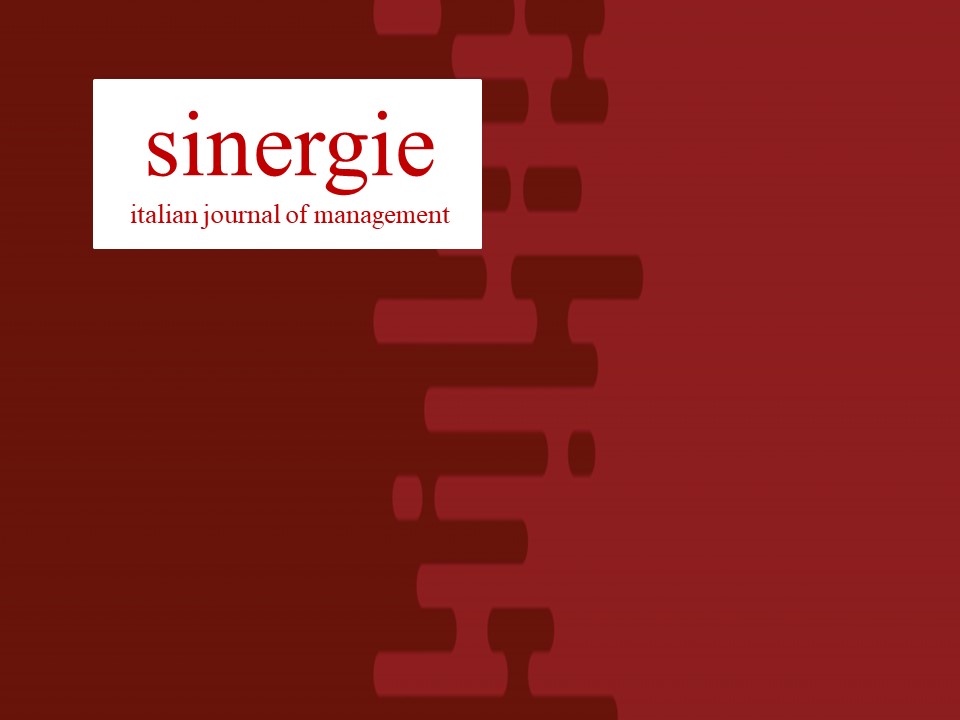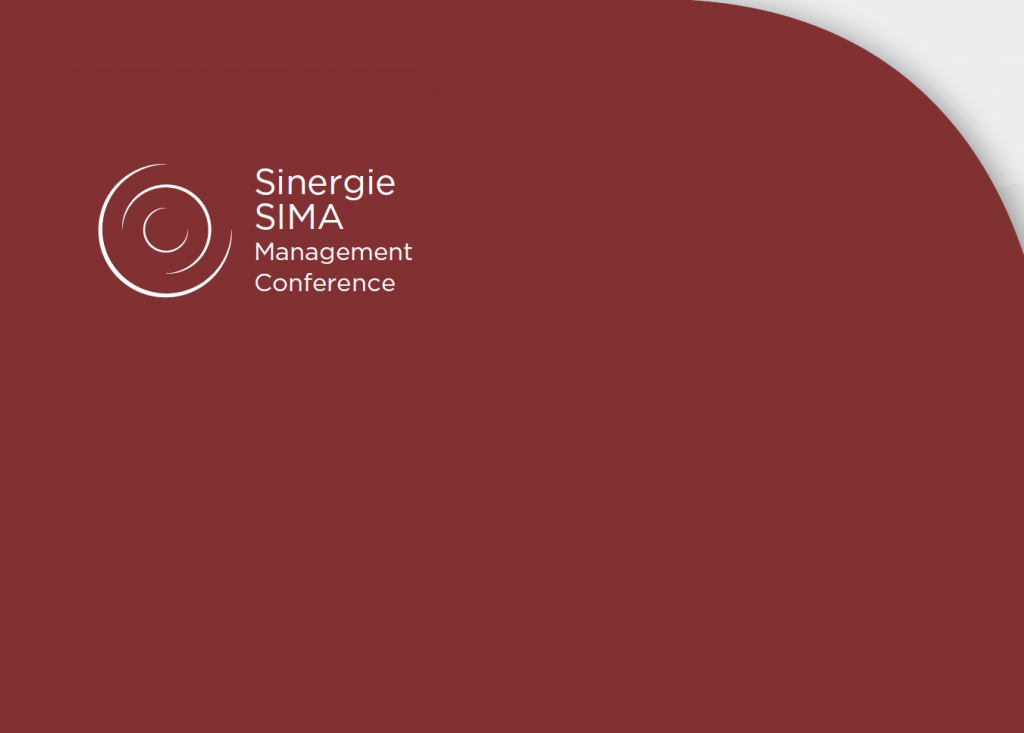Innovazioni gestionali e nuove relazioni sistemiche per la competitività dell'impresa
Obiettivo del paper: Il paper diretto a porre in evidenza alcune tappe significative dellevoluzione del pensiero economico sulle caratteristiche e sulle fonti dellinnovazione nellimpresa.
Metodologia: Analisi e confronto dei risultati di qualificate ricerche, svolte sulleconomia e sulla gestione dellinnovazione aziendale a livello internazionale.
Risultati: Viene posto in rilievo che linnovazione aziendale importante non soltanto di natura tecnologica (attinente ai processi, ai materiali e ai prodotti), ma che essa puessere anche organizzativa, gestionale o nelle relazioni sistemiche esterne.
Limiti della ricerca: Un limite evidente che il numero delle ricerche considerate non esaustivo, rispetto ai molti autori che hanno analizzato nelle proprie pubblicazioni le problematiche trattate in questo paper.
Implicazioni pratiche: Il lavoro ribadisce che il vantaggio competitivo dellimpresa puessere fondato su innovazioni, non soltanto tecnologiche, ma anche organizzativo-gestionali e nel modello di business.
Originalità del lavoro: Lo studio riesce ad illustrare sinteticamente come si sviluppato il concetto di innovazione, ai fini del miglioramento della competitivitdellimpresa.
Riferimenti bibliografici
AMIT R., ZOTT C. (2001), Value creation in e-business, Strategic Management Journal, n. 22, giugno-luglio, pp. 493-520.
ARMBRUSTER H., BIKFALVI A., KINKEL S., LAY G. (2008), Organizational innovation: The challenge of measuring non-technical innovation in large-scale surveys. Technovation, vol. 28, n. 10, pp. 644-657.
BACCARANI C. (2005), Le relazioni tra impresa e mercato: una questione di potere e di rispetto, Sinergie, n. 67, pp. 149-157.
BATTISTI G., STONEMAN P. (2010), How innovative are UK firms? Evidence from the fourth UK community innovation survey on synergies between technological and organizational innovations, British Journal of Management, vol. 21, n. 1, pp. 187-206.
CALIA R.C., GUERRINI F.M., MOURA G.L. (2007), Innovation network: from technological development to business model reconfiguration, Technovation, vol. 27, n. 8, pp. 426-432.
CAMISON C., VILLAR-LOPEZ A. (2011), Non-technical innovation: organizational memory and learning capabilities as antecedent factors with effects on sustained competitive advantage, Industrial Marketing Management, vol. 40, n. 8, pp. 1294-1304.
CAMISON C., VILLAR-LOPEZ A. (2014), Organizational innovation as enabler of technological innovation capabilities and firm performance, Journal of Business Research, vol. 67, n. 1, pp. 2891-2902.
CERNE M., JAKLIC M., SKERLAVAJ M. (2013), Decupling management and technological innovation: resolve the individualism-collectivism controversy, Journal of International Management, vol. 19, n. 2, pp. 103-117
CHESBROUGH H. (2010), Business Model Innovation: opportunities and barriers, Long Range Planning, vol. 43, n. 2-3, pp. 354-363.
CHESBROUGH H.W. (2003), Open innovation: the new imperative for creating and profiting from technology, Harvard Business School Press, Boston.
CHESBROUGH H., CROWTHER A.H. (2006), Beyond high tech: early adopters of open innovation in other industries, R&D Management, vol. 36, n. 3, pp. 229-236.
CHESBROUGH H., ROSEMBLOOM R.S. (2002), The role of business model in capturing value from innovation: evidence from Xerox Corporations technology spin-off companies, Industrial and Corporate Chang, vol. 11, n. 3, pp. 529-555.
CHRISTENSEN C.M., RAYNOR M.E. (2004), Il dilemma dellinnovatore: la soluzione, Etas Libri, Milano.
CONTRACTOR F.J., KUMAR V., KUNDU S.K., PEDERSEN T. (2010), Reconceptualizing the firm in a world of outsourcing and offshoring: the organizational and geographical relocation of high-value company functions, Journal of Management Studies, vol. 47, n. 8, pp. 1417-1433.
DAGNINO G. B., DALLURA G. M., FARACI R., PISANO V. (2011), La localizzazione dei processi innovativi ad alto contenuto tecnologico: il ruolo delle imprese ncora fra sistemi locali e network globali, Sinergie, n. 84. pp. 179-207
DAHALANDER L. GANN D.M. (2010), How open is innovation?, Research Policy, vol. 39, n. 6, pp. 699-709.
DAMANPOUR F., ARAVIND D. (2011), Managerial innovation: conceptions, processes and antecendents, Management and Organization Review, vol. 8, n. 2, pp. 423-454.
DAMANPOUR F., WALKER R.M., AVELLANEDA C.N. (2009), Combinative effects of innovation types and organizational performance: A longitudinal study of service organizations, Journal of Management Studies, vol. 46, n. 4, pp. 650-675.
DI GREGORIO D., MUSTEEN M., THOMAS D.E. (2009), Offshore outsourcing as a source of international competitiveness for SMEs, Journal of International Business Studies, n. 40, pp. 969-988.
DI MININ A., FRATTINI F., PICCALUGA A. (2010), Fiat: Open Innovation in a Downturn (1993-2003), California Management Review; vol. 52, n. 3, pp. 132-159.
DI STEFANO G., GAMBARDELLA A., VERONA G. (2012), Technolgoy push and demand pull perspectives in innovation studies: current findings and future research directions, Research Policy, vol. 41, n. 8, pp. 1283-1285.
DJELASSI S., DECOOPMAN I. (2013), Customer participation in product development through crowdsourcing: issues and implications, Industrial Marketing Management, vol. 42, n. 5, pp. 683-692.
DODGSON M., GANN D., SALTER A. (2006), The role of technology in the shift towards open innovation: the case of Procter & Gamble, R&D Management, vol. 36, n. 3, pp. 333-346.
FAGERBERG J., FOSAS M., SAPPRASERT K. (2012), Innovation: exploring the knowledge base, Research Policy, vol. 41, n. 7, pp. 1132-1153.
FAGERBERG J., VARSPAGEN B. (2009), Innovation studies – The emerging structure of a new scientific field, Research Policy, vol. 38, n. 2, pp. 218-233.
FULLER J., HUTTER K., FAULLANT R. (2011), Why co-creation experience matters? Creative experience and its impact on the quantity and quality of creative contributions, R&D Management, vol. 41, n. 3, pp. 259-273.
GAMBARDELLA A. (1999) (a cura di), Limpresa: vecchie e nuove fonti del vantaggio competitivo, Giappichelli, Torino.
GASSMANN O. (2006), Opening up the innovation process: towards an agenda, R&D Management, vol. 36, n. 3, pp. 223-228.
GASSMANN O., ENKEL E. (2004), Toward a theory of open innovation: three core process archetypes, Paper presented at R&D Management Conference, Lisbon 6 luglio.
GOLINELLI G.M. (2000), Lapproccio sistemico al governo dellimpresa (volume primo, Limpresa sistema vitale), Cedam, Padova.
GOVIDARAJAN V., GUPTA A.K. (2001), Strategic innovation: a conceptual road map, Business Horizons, vol. 44, n. 4 , pp. 3-12.
GREGORI G.L. (2001), Levoluzione del processo di outsourcing nelle strategie di sviluppo delle imprese, Giappichelli, Torino.
HAMEL G. (2006), The why, what and how of management innovation, Harvard Business Review, February, pp. 72-84.
HAMEL G. (2007). The future of management, Harvard Business School Press, Boston.
HAMEL G. (2009), Management innovation, Leadership Excellence, vol. 26, n. 5
HOWE J. (2006), The rise of crowdsourcing, Wired Magazine, vol. 14, n. 6 pp. 1-5.
HUIZINGH E.K.R.E. (2010), Open innovation: state of the rate and future perspectives, Technovation, vol. 31, n. 1, pp. 1-5.
KIM W.C., MAUBORGNE R. (1997), Value innovation: the strategic logic of high growth, Harward Bsuiness Review, vol. 75, n. 1, pp. 102-112.
KIM W.C., MAUBORGNE R. (1999), Strategy, value innovation and the knowledge economy, Sloan Management Review, vol. 40, n. 3, pp. 41-54.
KLINE S., ROSENBERG N. (1986), An overview of innovation, in Landu R., Rosenberg N. (a cura di), The positive sum strategy, National Academy Press, Washington D.C., 1986.
LAMPEL J., BHALLA A. (2011), Living with offshoring: the impact of offshoring on the evolution of organizational configurations, Journal of World Business, vol. 46, n. 3, pp. 346-358.
LICHTENTHALER U., LICHTENTHALER E. (2009), A capability-based framework for open innovation: complementing absorptive capacity, Journal of Management Studies, vol. 46, n. 8, pp. 1315-1338.
LUMPKIN G.T., DESS G.G. (1996), Clarifying the entrepreneurial orientation construct and linking it to performance, Academy of Management Review, vol. 21, n. 1, pp. 135-172.
MARTNEZ-ROS E., LABEAGA J.M. (2009). Product and process innovation: Persistence and complementarities, European Management Review, vol. 6, n. 1, pp. 64-75.
MATTHYSSENS P., VANDENBEMPT K., BERGHMAN L. (2006), Value innovation in business markets: breaking the industry recipe, Industrial Marketing Management, vol. 35, n. 6, pp. 751-761.
NANUT V., TRACOGNA A. (2003), Processi di internazionalizzazione delle imprese: vecchi e nuovi paradigmi, Sinergie, n. 60, pp. 11-34.
NELSON R.R., WINTER S.G. (1982), An Evolutionary theory of economic change, Harvard University Press, Harvard.
PAVITT K. (1991), Alcuni fondamenti di una teoria della grande impresa innovativa, in Giannetti R., Toninelli P. (a cura di), Innovazione, impresa e sviluppo economico, Il Mulino, Bologna.
PIVA M., SANTARELLI E., VIVARELLI M. (2005), The skill bias effect of technological and organizational change: evidence and policy implications, Research Policy, vol. 34, n. 2, pp. 141-157.
PORTER M.E. (1987), Il vantaggio competitivo, Edizioni di Comunit, Milano (trad. it. di Competitive Advantage, The Free Press, New Yok, 1985).
RAASCH C., VON HIPPLER E. (2013), Innovation process benefits: the journey as reward, MITSloan Management Review, vol. 55, n. 1, pp. 33-39.
ROSENBUSCH N., BRINCKMANN J., BAUSCH A. (2011), Is innovation always beneficial? A meta-analysis of the relationship between innovation and performance in SMEs, Journal of Business Venturing, vol. 26, n. 4, pp. 441-457.
RULLANI E. (2009), Rischio e valore della conoscenza – la nuova impresa della produzione immateriale, relazione presentata al 32 Convegno dellAIDEA, Universit Politecnica delle Marche, Ancona, 24-25 settembre.
SAWHNEY M., WOLCOTT R.C., ARRONIZ I. (2006), The 12 different ways for companies to innovate, MITSloan Management Review, vol. 47, n. 3, pp. 75-81.
SCHENK E., GUITTARD C. (2011), Towards a characterization of crowdsourcing practices, Journal of Innovation Economics & Management, vol. 1, n. 7, pp. 93-107.
SCHLEGELMICH B., DIAMANTOPOULOS A., KREUZ P. (2003), Strategic innovation: the construct, its drivers and its strategic outcomes, Journal of Strategic Management, vol. 11, n. 2, pp. 117-132.
SCHMEISSER B. (2013), A systematic review of literature on offshoring of value chain activities, Journal of International Management, vol. 19, n. 14, pp. 390-406.
SILVESTRELLI S. (1978), Modello di sviluppo industriale per disintegrazione verticale del settore: lindustria dei mobili in Italia, Economia e politica industriale, vol. 5, n. 18, pp. 109-143.
SILVESTRELLI S. (2004), Linnovazione nei settori industriali: implicazioni di mercato e nuove logiche concorrenziali, Sinergie, 64-65, pp. 25-64.
SILVESTRELLI S. (2012), Decisioni strategiche di impresa, Esculapio, Bologna.
TEECE D.J. (1986), Profiting from technological innovation: Implications for integration, collaboration, licensing and public policy, Research Policy, vol. 15, n. 6, pp. 285-305.
TEECE D.J. (2009), Business Models, Business Strategy and Innovation, Long Range Planning, vol. 43, n. 2-3, pp. 172-194.
VAN DE VRANDE V., DE JONG J.P.G., VANHAVERBEKE W., DE ROCHEMONT M. (2009), Open innovation in SMEs: trends, motives and management challenges, Technovation, vol. 29, n. 6-7, pp. 423-437.
VARALDO R. (1979), (a cura di), Ristrutturazioni industriali e rapporti tra imprese, Franco Angeli, Milano.
VARALDO R. (2006), Il nuovo modello competitivo e aziendale dei distretti industriali, Economia e politica industriale, vol. XXXIII n. 1, pp. 25-42.
VON HIPPEL E. (1978), Successful industrial products from custom ideas, Journal of Marketing, gennaio vol. 42, n. 1, pp. 39-49.
VON HIPPEL E. (1987), Cooperating between rivals: informal know how trading, Research Policy, vol. 16, n. 6, pp. 291-302.
VON HIPPEL E. (1990), Le fonti dellinnovazione, McGraw Hill, Milano.
VON KROGH G., HAFLIGER S., SPATH S., WALLIN M. (2012), Carrots and rainbows: motivation and social practice on open source software development, MIS Quarterly, vol. 36, n. 2, pp. 649-676.


